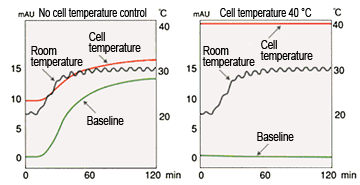Detector with Cell Temperature Control Enhances Analysis Reliability
In response to demands for higher analysis reliability in recent years, efforts have been made to reduce the effects of temperature on the detector. In addition to refractive index detectors and electroconductivity detectors that are generally known to be sensitive to environmental temperature fluctuations, Shimadzu has led the industry by offering fluorescence and UV detectors that incorporate cell temperature-control.
(1) Fluorescence Detectors Incorporating Cell Temperature Control
With fluorescence detectors, temperature control of the cell is extremely important for improving the signal reliability. That is because fluorescence is subject to a thermal quenching phenomenon.
Thermal Quenching of Fluorescence
The fluorescence intensity drops as the temperature increases due to a larger number of intermolecular collisions and higher degree of non-radiative deactivation transition. The size of this phenomenon depends on the sample. In some cases, the fluorescence intensity drops approximately 5 % for each 1°C temperature increase near room temperature.
Therefore, the fluorescence intensity decreases if the liquid temperature flowing into the detector flow cell increases. Room temperature fluctuations cause fluorescence fluctuations, which can affect sample quantification and reproducibility.

(RF-10AXL Super)
Configuration of Fluorescence Detector with Temperature-Controlled Cell
These problems can be largely overcome by maintaining the liquid flowing into the detector flow cell at a constant temperature.
Fig. 1 shows the configuration of the RF-10AXL Super flow cell that incorporates cell temperature control.
A heat exchanger is installed on the upstream side of the flow cell unit. This is heated or cooled by a heater or Peltier element to maintain a constant temperature. A stainless-steel pipe is incorporated in the heat exchanger. The eluate from the column flows through this pipe, where it attains a constant temperature before entering the flow cell.
Compared to normal electronic components, such as resistors and capacitors, the sensitivity and dark current of the photomultiplier tube used in a fluorescence detector are more easily affected by temperature fluctuations. Individual differences in the temperature coefficient exist between photomultiplier tubes. Therefore, photomultiplier tubes with a low temperature coefficient are pre-selected for the RF-10AXL Super. Moreover, with the RF-20Axs, the area around the photomultiplier tube is temperature-controlled.
Effects of Maintaining Constant Liquid Temperature
The charts below are sample chromatograms for an acridine sample measured with constant liquid-temperature control (Fig. 2) and without temperature control (Fig. 3). If liquid-temperature control is not used, a 5 °C temperature change results in a -17 % change in peak area value. However, if temperature control is used, this change is restricted to just 0.64 %. This shows that stable quantitative analysis is possible, even on samples with a high fluorescence intensity temperature coefficient.

(2) UV Detectors Incorporating Cell Temperature Control

For UV detectors, cell temperature control is effective for improving baseline stability and signal reliability.
Normally, ambient temperature fluctuations result in changes in the absorption spectrum. For acids, in particular, changes in the dissociation status (shifting the chemical equilibrium) due to the temperature make the absorption spectrum more susceptible to changes. Generally, the absorption band has a detailed structure at low temperatures but the spectral resolution deteriorates at high temperatures. In many cases, the absorbance drops as the temperature increases.
Baseline Stability
The UV detector is being used in the UV short-wavelength region in an increasing number of cases to detect more components. Generally, the absorbance of the mobile phase itself increases towards shorter wavelengths. The absorbance spectrum of the mobile phase changes with temperature and shifts in the wavelength direction (horizontally). The baseline becomes considerably unstable when detecting at wavelengths with a large absorption slope, in particular. With a UV detector incorporating cell temperature control, such as SPD-20A/20AV, the constant temperature of the liquid flowing into a cell prevents changes in the spectrum due to the mobile phase temperature and ensures stable analysis even at wavelengths with a large absorption slope.

Mobile phase: 20 mM phosphoric acid sodium buffer solution (pH 6.8) Flowrate: 1.0 mL/minute Detector: 210 nm
Signal Reliability
As the absorbance value fluctuates with temperature at the sample absorption maximum, cell temperature control is also effective with respect to signal reliability. For some samples, detection may occur on the absorption slope rather than the absorption maximum during multicomponent analysis at a single wavelength. Therefore, if the sample spectrum changes with temperature and shifts in the wavelength direction (horizontally), the peak height and area could more readily change due to temperature fluctuations than when measuring at the absorption maximum. Cell temperature control is more effective in such cases.
(Kk,Md)



